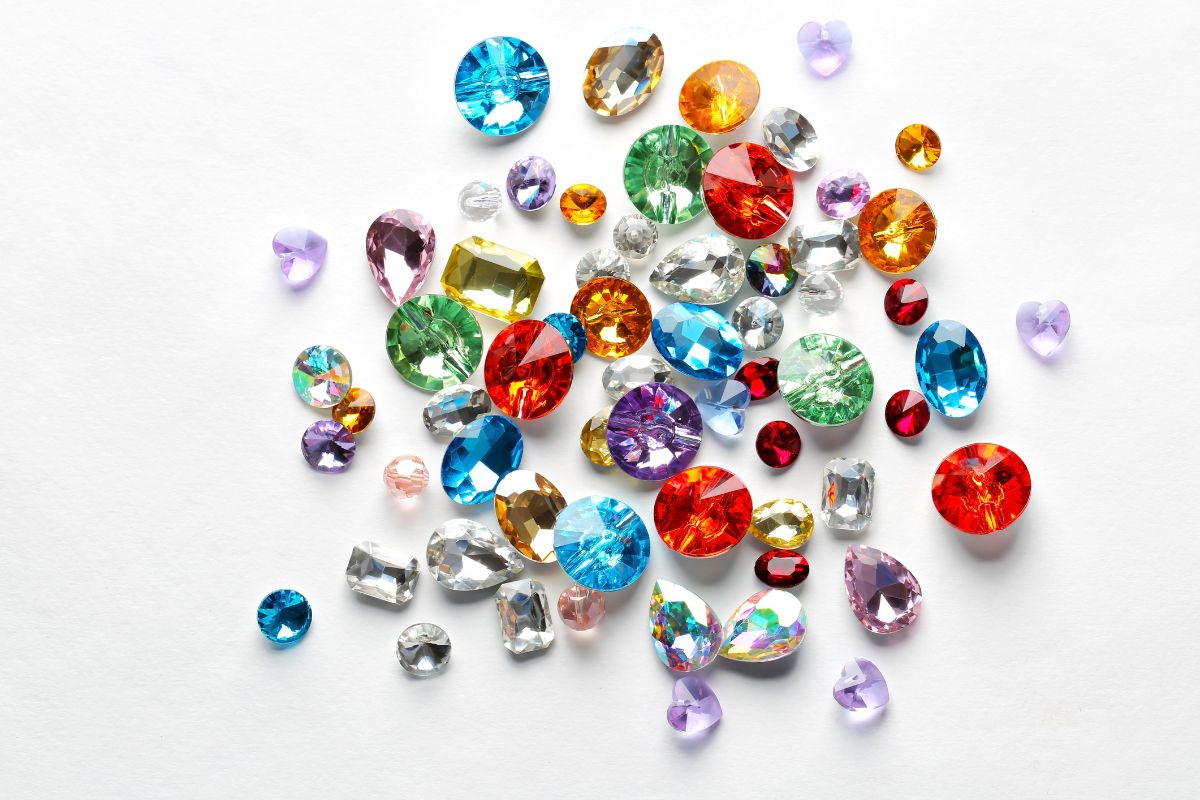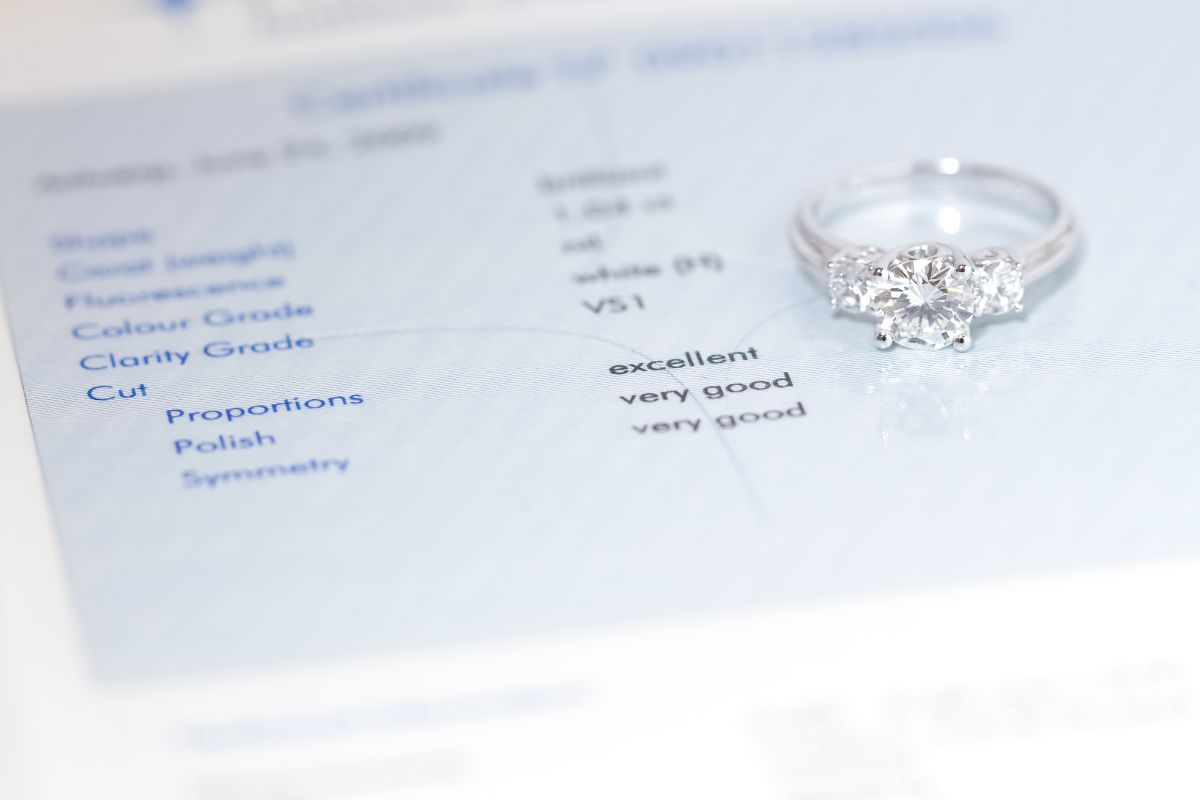
Gemstone Diamond Prices: Current Market Trends and Insights
When you think about gemstone diamond prices, it's essential to understand the factors that drive them.
Diamonds are not only valued for their beauty but also their rarity and demand in the market.
The price of diamonds fluctuates based on carat weight, color, clarity, and cut, with larger diamonds generally commanding higher prices.
Table Of Contents
- Fundamentals of Diamond Valuation
- Market Dynamics of Diamond Pricing
- Comparing Diamond Prices Across Different Shapes and Cuts
- The Influence of Gemstone Type on Valuation
- Buying Diamonds: Retail vs. Online Markets
- The Significance of an Engagement Ring's Gemstones
- Tools and Resources
- Frequently Asked Questions
Gem diamond prices showcase interesting patterns such as notable price jumps at certain carat thresholds. For instance, there can be significant premiums for a diamond just slightly larger than another, like between a 0.49-carat and a 0.50-carat diamond.
These nuanced distinctions can have a surprisingly large impact on pricing, often driven by consumer perception and market demand.
You might also find it interesting how diamonds relate to broader economic trends. Inflation indicators, like the Consumer Price Index (CPI), show strong correlations with diamond price movements.
This dual link between intrinsic qualities and external economic factors makes diamond pricing a dynamic and sometimes unpredictable aspect of the gemstone market.
Fundamentals of Diamond Valuation
When determining the value of a diamond, several key factors are taken into account.
Known as the 4 Cs—Carat, Cut, Color, and Clarity—these essential attributes play a significant role in the pricing and desirability of diamonds.
Understanding the 4 Cs
The 4 Cs form the cornerstone of diamond valuation. They provide a standardized way to assess diamond quality and price.
Most buyers and sellers consider these characteristics to make informed decisions.
Carat refers to the weight, Cut affects how a diamond shines, Color indicates how colorless it is, and Clarity relates to imperfections.
Together, these factors determine how a diamond is graded and priced in the market.
Carat Weight and Its Impact on Price
Carat weight measures a diamond’s size. It significantly influences diamond prices.
Larger diamonds (higher carat weights) are generally more expensive because they're rarer.
The price often increases disproportionately with carat weight. For example, a 1-carat diamond might not simply be twice the price of a 0.5-carat diamond.
Price per carat increases as size grows, reflecting the rarity and demand for larger stones.
Role of Cut in Aesthetics and Value
A diamond’s cut greatly affects its brilliance and sparkle. Unlike other aspects, cut quality is decided by human skill.
The precision of cuts determines how well light reflects within the diamond.
An excellent cut enhances a diamond’s visual appeal, making it more valuable. Even if two diamonds have similar carat weight, color, and clarity, their cuts can lead to significant price differences.
Superior cuts allow for greater light reflection, boosting the aesthetic and monetary value.
Color Grading and Price Variations
The color of a diamond is graded based on its lack of color. The grading scale ranges from D (colorless) to Z (noticeably colored).
The more colorless a diamond, the higher its value.
Color impacts the aesthetic appeal of the diamond. Colorless diamonds are prized for their purity. Even slight differences in hue can lead to considerable shifts in price.
Understanding these color grades can help you assess how much you should pay for specific diamond colors.
Clarity: Imperfections and Value
Clarity refers to the presence of internal or external flaws, known as inclusions or blemishes.
The fewer the imperfections, the higher the diamond's clarity and value.
Clarity grades range from flawless (no visible inclusions) to included (imperfections visible to the naked eye). Even minor imperfections can significantly impact prices.
Knowing the clarity grade helps you understand the diamond’s overall quality and whether its price justifies its condition.
Market Dynamics of Diamond Pricing

Understanding how diamond prices are set can help you navigate the diamond market. Factors such as market reports, inventory levels, and the growth of lab-created diamonds all play a role. This section breaks down how pricing dynamics work in the diamond industry.
The Rapaport Diamond Report Explained
The Rapaport Diamond Report is essential for anyone buying or selling diamonds. It provides a detailed analysis of prices based on factors like size, clarity, and color.
Updated weekly, the report is often referred to as the "price list" in the industry. You can use it to compare and negotiate prices.
The report sets a benchmark for market transactions, ensuring that you have a reliable guide. This enables both buyers and sellers to make informed decisions, creating a level playing field.
Diamond Price Index and Trends
The diamond price index tracks changes in diamond prices over time. It reflects global pricing trends, making it an important tool for investors and traders.
In recent years, prices have seen fluctuations due to economic conditions and changes in supply and demand.
Monitoring these trends gives you insights into when it might be a good time to buy or sell. Knowing how to read and interpret the index helps you anticipate market changes and set realistic buying expectations.
Influence of Diamond Inventory on Prices
Diamond inventory levels can significantly affect pricing.
When the inventory of polished diamonds is high, prices tend to level off or decrease. Conversely, low inventory may drive prices up as demand exceeds supply.
You can look to large diamond companies, like De Beers, which often hold significant stockpiles. Their inventory decisions can impact market dynamics.
Understanding these shifts allows you to better predict price changes.
Lab-Created Diamonds vs. Natural Diamonds
Lab-created diamonds are gaining popularity. They offer a lower-cost alternative to natural diamonds.
Price dynamics for these diamonds differ, as the production process can be controlled, impacting supply and demand balance.
While lab-created diamonds are often less expensive, they challenge traditional views and might influence the market for natural diamonds.
Understanding the differences in pricing between these two types will help you choose based on budget and personal preference.
Comparing Diamond Prices Across Different Shapes and Cuts
✨ Round Cut
Price Range: $8,000 - $12,000
Ideal Price: $10,000
💖 Princess Cut
Price Range: $6,000 - $10,000
Ideal Price: $8,000
💍 Oval Cut
Price Range: $7,000 - $11,000
Ideal Price: $9,000
💫 Emerald Cut
Price Range: $5,000 - $9,000
Ideal Price: $7,000
When buying diamonds, the shape and cut play important roles in determining the price. Different shapes cater to varying tastes and price perceptions. Meanwhile, the cut influences the visual appeal and overall cost of the diamond.
Price Perceptions of Popular Diamond Shapes
The round brilliant shape is often the most expensive. Its symmetry and light performance make it highly sought after.
Princess cut diamonds are usually less expensive than round ones. Their square shape offers a modern look that appeals to many buyers.
Emerald and cushion cuts create elegant styles. They don't sparkle as much as round diamonds but can cost less.
When looking at heart-shaped diamonds, you can expect prices similar to round diamonds. Their unique look makes them popular for romantic gifts.
Here's a quick comparison of average costs:
How Diamond Cut Affects Pricing
The cut of a diamond impacts its sparkle and value. A well-cut diamond reflects light beautifully, enhancing its brilliance.
There are several cut quality grades. Ideal cut or excellent cut diamonds often have premium prices. Their superior craftsmanship increases their value.
Very good cut diamonds offer a balance between beauty and price. They have slight imperfections but are still visually appealing.
Good or fair cut diamonds are budget-friendly. They reflect less light but still make great options for those prioritizing size over sparkle.
The cut affects not only price but also how a diamond looks. A better cut means more brilliance and thus a higher price tag.
Buyers should weigh cut quality against their budget and visual preferences.
The Influence of Gemstone Type on Valuation

The type of gemstone significantly affects its valuation, with factors like rarity, demand, and uniqueness playing a key role. Understanding these differences can help you make informed decisions when buying or investing in gemstones.
Contrasting Diamond with Colored Gemstones
Diamonds and colored gemstones differ drastically in terms of valuation. Diamonds are often valued based on the "Four Cs": cut, color, clarity, and carat weight. These aspects create a standard guideline, making diamond pricing relatively predictable.
Colored gemstones, such as sapphires, rubies, and emeralds, are valued differently. Their color saturation, tone, and origin are more critical than size and clarity.
For instance, a vibrant, deep blue sapphire from Kashmir could fetch a higher price compared to those from other regions, regardless of carat size.
Assessing Sapphire, Ruby, and Emerald Prices
When looking at colored gems, sapphires, rubies, and emeralds are particularly notable for their prestige and price.
Sapphire prices vary significantly based on their color, with blue sapphires being the most highly valued. The famed Kashmir sapphires are especially prized due to their rarity and intense color.
Emeralds and rubies are valued for their rich colors as well. Rubies with a deep "pigeon blood" hue are considered the most valuable. Similarly, Colombian emeralds are sought after for their unique color and clarity.
These factors make these stones both a prestigious choice and a complex market for valuators.
Emerging Trends in Valuable and Affordable Gems
Valuable gems continuously capture interest, while some more affordable options are gaining popularity.
Sought-after stones like aquamarine, opal, and peridot offer alternative choices for those interested in budget-friendly yet exquisite pieces.
Aquamarine is beloved for its ocean-like hue, while opals captivate with their play-of-color. Peridot, with its vibrant greenish-yellow shade, presents an affordable and appealing option.
These gems’ accessibility does not detract from their beauty, making them a viable investment or purchase choice for a wider audience.
Buying Diamonds: Retail vs. Online Markets

When considering diamond purchases, it's important to look at the differences between shopping online and in traditional retail stores. Each offers unique advantages and challenges, from pricing variations to the purchasing experience.
Navigating Online Diamond Sales
Buying diamonds online can offer benefits like competitive diamond prices and a wide variety of options. Online jewelry sellers often provide detailed descriptions and visual aids that help you inspect each diamond's qualities from your own home.
Using online filters, you can compare carat size, color, clarity, and cut easily.
However, you must also be cautious.
Ensure that the online store has a solid return policy and clear information on diamond certification. Consider reading reviews and checking third-party ratings to validate the seller's credibility.
Understanding the role of online diamond calculators may help you see how factors like weight and rarity impact pricing.
Understanding Retail Price Factors
Retail diamond prices are often higher because they include overhead costs like leasing storefronts, staffing, and maintaining inventory.
These stores offer a hands-on buying experience, allowing you to see and feel the diamonds before purchasing. Many customers value speaking face-to-face with experienced staff for guidance.
In physical stores, prices can be influenced by the jeweler's reputation and exclusivity of the diamond cut or setting.
As a buyer, understanding industry-standard pricing models in these settings can help you negotiate better prices. Keep in mind that retail stores often offer exclusive styles or unique settings not available online.
The Significance of an Engagement Ring's Gemstones
Selecting the right gemstones for an engagement ring carries deep cultural and personal meanings.
Diamonds remain a popular choice, but factors like size, quality, and type of stone greatly impact the ring's symbolism and cost.
Choosing the Right Gemstone for an Engagement Ring
When picking a gemstone for an engagement ring, consider what the stone symbolizes to you and your partner.
Diamonds are classic, representing eternity and strength. Yet, some choose colored gemstones like sapphires or rubies for their unique meanings and beauty.
Each gemstone has unique characteristics.
Diamonds are prized for their durability and sparkle. Other gemstones may offer distinct colors and lower costs, providing personalized and budget-friendly options.
Consider using gemstones that reflect personal values or birthstones for added significance.
Before choosing, learn about the stone's quality factors like cut, clarity, and carat weight. These affect both its appearance and price.
Understanding these can help you make an informed decision that aligns with your budget and desires for a lifelong symbol of love.
Diamond Engagement Ring Pricing Guide
The price of a diamond engagement ring is influenced by the four Cs: carat, cut, clarity, and color. These factors determine the quality and value of the diamond.
Carat weight affects the diamond's size and price, with larger diamonds generally costing more.
Cut impacts how brilliantly a diamond shines, while clarity refers to the presence of tiny imperfections. A diamond’s color is graded on a scale from D (colorless) to Z (light color).
To determine the best value for your money, balance these factors based on your budget and preferences.
Sometimes, a smaller diamond with a high-quality cut may look more brilliant than a larger, poorly cut stone. Consider what matters most to you and use that to guide your choice.
Tools and Resources

When evaluating the price of diamond gemstones, it's crucial to use the right tools and resources. This includes utilizing a diamond price calculator and understanding certifications and appraisals to accurately gauge the value of cut gems.
Using a Diamond Price Calculator
A diamond price calculator is an essential tool for anyone dealing with diamonds. It helps you estimate the value of a diamond by considering factors like carat weight, cut, color, and clarity.
These calculators use industry standards and current market data to provide a price range.
To get accurate results, input precise details of your gemstone. Adjust the parameters to match the specifications of the diamond you are evaluating.
Some calculators also include additional features like currency conversion, allowing you to see the value in different markets. Remember that while digital tools are beneficial, their outputs should be compared with professional opinions.
Certifications and Appraisals
Certifications and appraisals play a critical role in the valuation of diamonds.
Certification from authoritative bodies like the Gemological Institute of America (GIA) confirms the authenticity and quality of a diamond. This ensures transparency and trust in transactions.
Appraisals provide a market-based value of a diamond. Expert appraisers consider both the stone's inherent qualities and current market conditions.
Ensuring your diamond is certified and appraised correctly can affect not only its immediate sale price but also its insurance valuation.
Always work with certified professionals to ensure accurate and reliable assessments of your gems.
Also Read
Frequently Asked Questions
When discussing diamond prices, several factors play a crucial role. These include how diamonds are measured, the influence of market trends, and quality differences between natural and synthetic stones.
How are diamond prices evaluated per carat?
Diamond prices are generally evaluated based on their weight in carats. Each carat is divided into 100 points, and prices often increase significantly with each carat weight increment.
What factors influence the current market price of a diamond?
Several factors influence diamond prices, including carat weight, cut quality, color, and clarity. Market demand and supply, as well as certification from reputable grading labs, also play important roles.
How much does a 1 carat diamond typically cost?
A 1 carat diamond's cost can vary significantly depending on its quality and market conditions. Prices can range anywhere from a few thousand to over ten thousand dollars.
What is the price difference between natural and synthetic diamonds?
Synthetic diamonds, or lab-grown diamonds, are usually less expensive than natural diamonds. The price difference can be substantial because synthetic diamonds avoid the mining costs and scarcity associated with natural diamonds.
How does gemstone quality affect diamond valuation?
The quality of a diamond—often referred to as the Four Cs: cut, color, clarity, and carat weight—affects its valuation. High-quality stones with better cut, color, and clarity are more valuable and sought after.
Can the price of diamonds vary based on carat weight increments?
Yes, diamond prices can vary dramatically with slight increases in carat weight. This price jump is particularly noticeable at popular weight benchmarks, such as 1.0 carat or 2.0 carats, due to increased demand for these sizes.
Checkout some of our top collections:
- Moissanite Engagement Rings
- Moissanite Earrings
- Moissanite Bracelets
- Moissanite Solitaire Engagement Rings
- Moissanite Mens Engagement Rings
- Moissanite Princess Cut Stones
- Lab Grown Engagement Rings
- Lab Grown Diamond Earrings
- Lab Grown Diamond Wedding Bands









